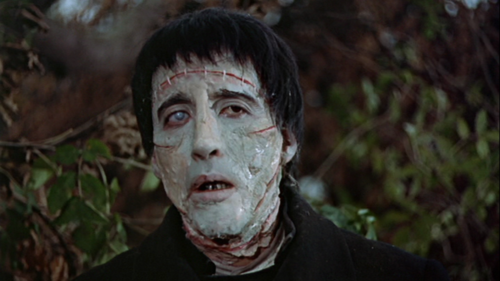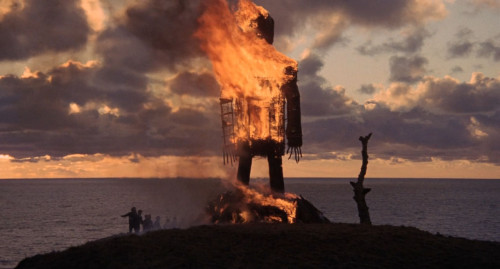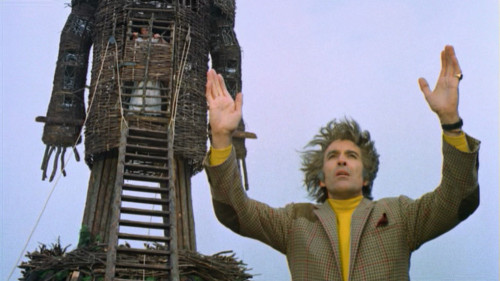In Memory of Christopher Lee – An Analysis of The Wicker Man (1973)
Last month marked the passing of cinematic giant Christopher Lee who was credited in over 200 movies. His loss was felt particularly strong in those who remembered him from their childhoods in the roles of Saruman from the LOTR trilogy and Count Dooku from the Star Wars saga (as well as the odd turn in the ever-popular Tim Burton outings). This is a wonderful testimony to a 93 year old man who was still able to reach out and be relatable to younger audiences. For many of us, he was our first introduction to truly terrifying villans in cinema and as a result was a massive pop culture icon of our generation, especially for sci-fi and fantasy fans, and he will be fondly remembered by many of us.
However, I will not be looking back on these flicks for this memorial piece as I imagine that these will have already been covered and adequate tributes will have been given to the man in these film roles. In no attempt to undermine the importance of his later movie roles, I personally want to discuss his much earlier contributions to cinema and their significance in helping to shape British film and British Horror in particular.
In the forties and fifties, Lee was a mostly unknown actor until he was thrusted under the spotlight during his turn as “The Creation” in the Hammer Film Productions’ “The Curse of Frankenstein” (1957 – pictured above), one of the first horror movies in colour. It was thus packed with spurts of bright red blood, the likes of which had never been seen before and would have caused real revulsion for audiences back then. Lee was chosen for the part, similarly to Boris Karloff, for his distinctive facial features which would have provided a wealth of opportunities for the make-up department in a horror production. From then on, Lee frequently appeared in the Hammer Film Productions, which had soon turned into a horror powerhouse, often opposite Peter Cushing, with the pair most memorably portraying Dracula and Dr Van Helsing in Dracula (1958).
These days, the mention of Hammer Horror often invokes a snigger – a victim of tight budgeting, the films are full of special effects that do not hold up against the test of time: lots of bats on strings y’know; and have even be cruelly dubbed as “camp”. It is easy enough to see why they would be stuck with such a label for towards the end of the company’s run in the 70s, the films had become a parody of themselves and were churned out like Mills and Boones novellas. Even so, Hammer had produced a long run of genuinely frightening horror movies (the gore was unlike anything that had ever been seen in cinema, impressive considering formal film ratings were only brought in by 1968). The bold new strides made by Hammer in turn heavily influenced both European and Hollywood Horror at the time including Mario Bava’s sumptuous “Mask of Satan/Black Sunday” (1960); and the American Independent filmmaker Roger Corman, who directed several adaptations of Edgar Allan Poe’s work including “The Masque of the Red Death”(1964).
To credit Hammer Horror in helping to redefine a new age of Horror cinema, Lee and Cushing deserve much recognition as they were absolute pillars and were seen in many other independent productions at the time. The chemistry between the two is rarely trumped, their interactions are always hugely enjoyable to watch, especially their energetic fight sequences. As a result I always experience slight pangs of disappointment when I sit down to a Hammer and realise they aren’t in it. Furthermore, Lee has the perfect screen presence for horror: on the many occasions he has played Dracula and Frankenstein’s Monster, he barely utters a word but still musters a terrifying performance. His Dracula is a snarling, lusting animal; his creation is a mournful, confused and thus enraged soul. Lee brought sensuality back into the role of Dracula which had been lacking in previous movie adaptions but was a key part of the original literature; he was the original sexy vampire, making Edward Cullen look like a sad and moany schoolboy in comparison.
So, as discussed, Christopher Lee was a hugely important face in British Horror from the 50s to the 70s. This was an extremely important era for horror, due to the creation of the film rating system and to the new strides made at the time, such as the introduction of colour and with it more gore, blood and sex. Lee deserves as much possible credit for his contributions to this inventive time for horror. In further tribute I want to discuss a great movie from this film era from a subgroup of horror – folk horror – and the film in question: The Wicker Man (1973).
Yes, I know it’s hard to think of The Wicker Man and not conjure up images from the 2006 remake including Nicholas cage punching numerous women in the teeth and his massive scenery chewing. This flimsy retelling is so ingrained into our pop culture that to this day, whenever I mention Nicholas Cage I greatly struggle not to cry out “NOT THE BEES!” Now, I’m all for laughing whole-heartedly at ‘so bad they’re good’ films, but the problem with the remake is that it is so ridiculously bad it totally outshines the original which ends up being ignored. This is a mortal cinematic sin of the worst kind as the original is so thumpingly brilliant and it is honestly upsetting that Nicholas Cage’s shit [pardon my French] acting is causing cinephiles to miss out on a truly chilling horror flick. From this point on my advice to you is ignore the remake, purge every image of Nic Cage from your mind now!
Now we can get to business. A policeman comes to a remote island in the Outer Hebrides of Scotland after receiving an anonymous tip-off about the disappearance of a local girl, Rowan Morrison. Sergeant Howie is a very conservative Christian and immediately upon his arrival is shocked and appalled at not only the residents’ licentious behaviour, but also at their total abandonment of Christianity which instead is replaced by apparent paganism. Further disgust and dismay is fuelled by the islanders total lack of co-operation in the investigation of the girl’s disappearance (even Rowan’s mother seems apathetic towards the whole matter). As the determined sergeant digs deeper, he comes to the conclusion that something far more sinister may be afoot.
It would be easy to think that the shock experienced by Howie as he learns of the villagers’ rites would not sit with a contemporary audience, as probably many would not empathise with his uber Christian sensibilities and probably wouldn’t share in many of his outcries and protests. And certainly it is true that the Sergeant’s earnest dedication to his faith may not be relatable to a modern audience. We do however, still share in his revulsion in the reveal of the increasingly disturbing paganistic traditions and rituals of the island, with themes that could shock all walks of a multicultural and secular society.
Sexual liberty is a running theme throughout and was also an important part of this era of history, helping to destroy social taboos and oppressive restrictions from our society. However, in The Wicker Man (1973), it is used as a disturbing element as it seems to rob the local schoolchildren of their innocence: the maypole’s symbolism of male virility is described in such a matter-of-fact way to young girls whilst another class of young boys dance with full gusto around one – it all just seems kinda perverted leaving both the sergeant and audience flabbergasted. ‘So what? The teacher just said the word “penis” in front of schoolgirls; all children go through sex education an important part of growing up.’ True, but this wasn’t a sex ed lesson. Instead it was the teaching of the island’s doctrine, leading to the worrying conclusion of brain-washing of the worst possible kind. Throughout the film we witness many of the local children take part in dangerous and disturbing customs (such as jumping through rings of fire and holding frogs in their mouths) all of which are fully encouraged by all adults present. The corruption of the children’s innocence is consolidated by the reveal of the same schoolgirls gleefully partaking in the torture of animals.
We are also able to share in Howie’s frustration as villager after villager refuse to submit any information, only subtly hinting at the girl’s whereabouts before waving off the urgency of the situation as they stare into space murmuring about reincarnation and returning to the Earth. The villagers’ faith providing a “comfort” in the fulfilment of Rowan’s destiny by her body returning to the Earth is infuriating, making you and Howie want to shake the sense into all of the seemingly deluded locals. The precedence of the intricacies of “The Afterlife” over the possible grisly demise of the innocent child seen in almost all of the villagers Sergeant Howie meets is absolutely enraging, but it eventually leads to an absolutely terrifying conclusion – human sacrifice! Surely they couldn’t have?… Even worse is the prospect that the girl may have happily gone to her fate, dumb like a lamb to slaughter.
The movie also excels in the fact that several elements of the picture could have been laughable but instead helped to add to the nauseating and uncomfortable atmosphere of the film, creating actual moments of real terror and tension. I probably should have mentioned this earlier but the film is quite… errm… musical, with several moments in which the cast actually sing including the songs “Maypole”, “Fireleap”, “Willow’s Song”, some of which derived from Robert Burn’s ballad “The Highland Widow’s Lament” and even nursery rhymes like “Ba Ba Black Sheep” and “Oranges and Lemons”. Normally, I would not take a musical horror very seriously as they conjure images of “Little Shop of Horrors” and “Rocky Horror Picture Show” but these musical interludes performed by different characters actually help to immerse the senses into the world of this strange little island, helping to create a suffocating and intoxicating atmosphere as we are further dragged into the story. The aforementioned “Willow’s Song” performed by Lesley Mackie (who plays Daisy) is used in an attempt to seduce the virginal Howie. His resistance causes him almost physical pain. The film culminates and ends with the whole villages’ rendition of “Sumer Is Icumen In”, making the ending seem more devastating as it is all now evident that the whole island has succumbed to the indoctrination of their barbaric religion.
Also in the last half hour of the film, the locals prepare for their May Day festival and all dress up in a variety of down-right weird garb. The sights of Christopher Lee in unusual witch drag, a fully-grown bearded man (which wouldn’t seem out of place in a model-making enthusiast’s meeting) dressed in a tent-like hobby horse outfit should be hilarious. The absolute opposite effect instead results, for in the last chapter of the film the grisly details of the festivities of the island are revealed in a climax that builds up with the dread experienced by the audience, which the grotesque fancy dress adds to. The claustrophobic build-up to the end is worsened by the use of “innocent children”, many of whom are masked along with the whole village, participating in a gruesome version of the playground favourite Oranges and Lemons; and again it is this theme which really provides the sting in the devastating ending.
Christopher Lee plays Lord Summerisle who is seemingly the ringleader in the island’s dedication to ancient Celtic gods, and who wholeheartedly encourages the terrifying activities of the local youths. He incites the hatred of Howie with his proclamation that God is dead and is his antithesis. Lee, as usual, is on top form here, all suave and civilities initially but someone who uncovers the brutish tyranny that he has successfully cast over the island who now happily follow him in the archaic rites of their rediscovered religion. He also perfectly portrays the insanity of the man shown via his absolute devotion in his faith and his delights in its liberalities; he is a man that cannot be reasoned with and will only stop when the bloodshed he finds necessary is committed. What is so terrifying about his performance is that he is civil and almost shows adoration, sympathy and pity to his victims, but remains steadfast in his purpose.
With this movie Lee was trying to distance himself from his previous Hammer Horror roles in fear he may be type-cast. Strangely enough, the film was also trying to distance itself from the horror norms which Hammer had established (however revolutionary they were when first introduced) limiting the blood and gore and evoking horror via suggestion and mystery. The film and Lee absolutely succeeded in this; The Wicker Man is now a beacon that outshines and stands tall above the vast sea of mediocre horror and is a shining example to any future filmmakers showing us that jump–scares and blood spurts are not necessary to make a bone-chilling horror. Also this is one of Lee’s most enigmatic roles ever; showing that evil can come in all guises, including self-proclaimed righteousness. He manages to invoke empathy in the audience in such a way that you almost take his side… almost.
The film is a delicious treat for the eyes; Scotland has never looked so sunny. The costumes used in the ritual help give the feel of being transformed back into ancient Briton under Celtic reign. The supporting cast present such joy in their festivities and faith that coupled with the catchy soundtrack, you’ll be wondering where you can sign up for the cult (no really, it looks such fun). Despite the fact that the displayed paganism shocks and offends us, it gives a thoughtful commentary that Christianity may be guilty of the displayed indoctrination, the pagan lifestyle seems to be more free, accepting and non-judging especially in comparison to Howie’s strictly observed virginity.
So, if you want to pay tribute to the brilliant Christopher Lee, I massively recommend giving this a watch. What better way to send up a cinematic legend by remembering him in one of the greatest British Movies ever made? I hope you have fun on Summerisle, but remember, stay far away from the local festivities.
Recommended for you: Where to Start with Christopher Lee




